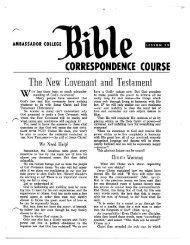Crucifixion Was Not on Friday (1968)_b.pdf - Herbert W. Armstrong
Crucifixion Was Not on Friday (1968)_b.pdf - Herbert W. Armstrong
Crucifixion Was Not on Friday (1968)_b.pdf - Herbert W. Armstrong
Create successful ePaper yourself
Turn your PDF publications into a flip-book with our unique Google optimized e-Paper software.
The <str<strong>on</strong>g>Crucifixi<strong>on</strong></str<strong>on</strong>g> <str<strong>on</strong>g>Was</str<strong>on</strong>g> <str<strong>on</strong>g>Not</str<strong>on</strong>g> <strong>on</strong> <strong>Friday</strong> 35<br />
mo<strong>on</strong> may occur at any time during the m<strong>on</strong>th. Most people<br />
today probably d<strong>on</strong>'t even know when a new mo<strong>on</strong> appears!<br />
Whatls the Average Length of a M<strong>on</strong>th?<br />
Even though some m<strong>on</strong>ths according to<br />
the Sacred or<br />
Hebrew Calendar have 29 days and others 30 days, the AVERAGE<br />
length of a m<strong>on</strong>th from <strong>on</strong>e new mo<strong>on</strong> to another is equal to 29<br />
days 12 hours 44 minutes and 3-Y3 sec<strong>on</strong>ds. You can find this<br />
informati<strong>on</strong> in the 11th editi<strong>on</strong> of the Encyclopaedia Britannica,<br />
article "Calendar." Or go to almost any book <strong>on</strong> the subject<br />
of the Hebrew Calendar.<br />
If these figures seem new to you reread this booklet when<br />
you've finished.<br />
This divinely appointed average length of the m<strong>on</strong>th is the<br />
mathematical basis of the Sacred Calendar! D<strong>on</strong>'t forget it.<br />
Memorize it! Say to yourself that "a sacred m<strong>on</strong>th averages 29<br />
days 12 hours 44 minutes and 3% sec<strong>on</strong>ds!"<br />
Actually an "hour," according to God's Calendar is not<br />
divided into 60 minutes or into 3600 sec<strong>on</strong>ds. The ancient<br />
Babyl<strong>on</strong>ians originated this idea. God originally divided the<br />
hour into 1080 "parts." Since there are 1080 "parts" in an<br />
hour, then a part is equivalent to 3 l h sec<strong>on</strong>ds.<br />
It does not really matter whether you sayan hour has 3600<br />
"sec<strong>on</strong>ds" or 1080 "parts." Or whether you say a m<strong>on</strong>th<br />
averages "29 days 12 hours 44 minutes and 3% sec<strong>on</strong>ds" or "29<br />
days 12 hours and 793 parts." This latter is the way the latest<br />
editi<strong>on</strong> of the Britannica records it. Jews would write it this<br />
way also.<br />
Either way of expressing it means the same thing. For<br />
"793 parts" equal "44 minutes and 3 l h sec<strong>on</strong>ds." (Since a<br />
"part" equals 3% sec<strong>on</strong>ds, 793 X 3% sec<strong>on</strong>ds = 2643 % sec<strong>on</strong>ds<br />
- or 44 minutes and 3lh sec<strong>on</strong>ds.)<br />
Since most of you are familiar with minutes and sec<strong>on</strong>ds,<br />
we shall write in abbreviated form for simplicity that, FOR<br />
RELIGIOUS PURPOSES, a m<strong>on</strong>th according to the Hebrew Calendar<br />
averages 29d 12h 44m and 3~s from <strong>on</strong>e new mo<strong>on</strong> to another.<br />
But this is not the <strong>on</strong>ly difference between the Hebrew<br />
Calendar and the Roman Calendar.

















